May 24 - 30, 2015: Issue 215
Harbour Trust wins another prestigious heritage award;
for the Excavation, Conservation, Reconstruction and Interpretation of the Cockatoo Island Solitary Confinement Cells
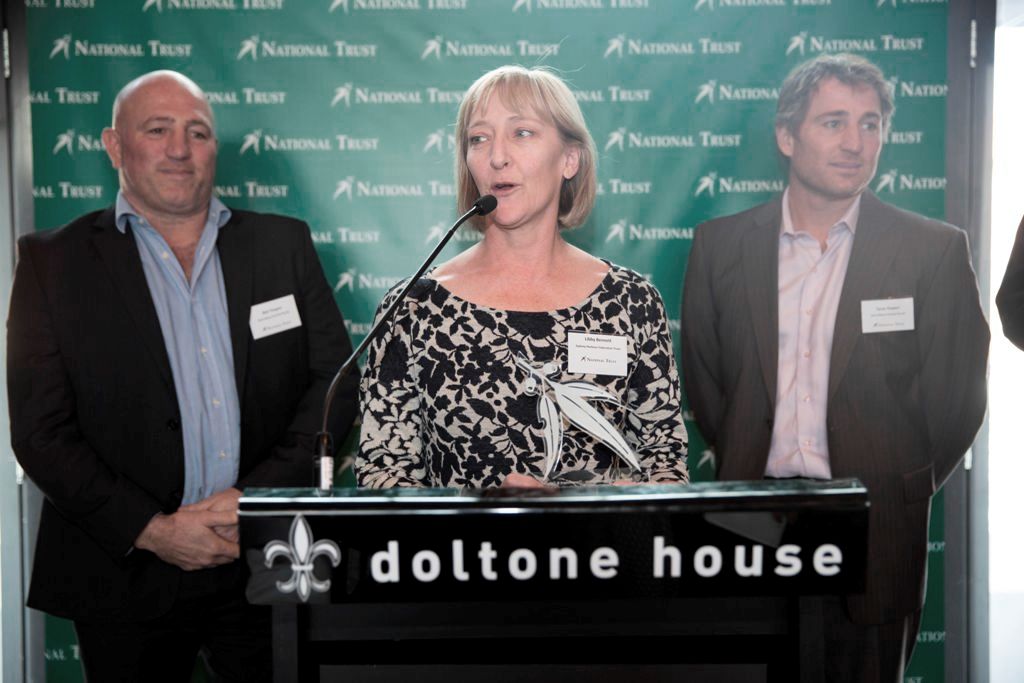
Top: Harbour Trust’s Libby Bennett accepts the Research and Investigation Award at the 2015 National Trust NSW Heritage Festival Awards - Photo courtesy National Trust of Australia (NSW).
The Sydney Harbour Federation Trust is pleased to announce that it has been awarded the Research and Investigation Award at the recent National Trust NSW Heritage Festival Awards. The award was presented for the Excavation, Conservation, Reconstruction and Interpretation of the Cockatoo Island Solitary Confinement Cells and Cookhouse, which was praised by the judges as “as an invaluable educational tool not only about the life of convicts on Cockatoo but about the project itself which was meticulously executed”.
“The discovery of the two solitary confinement cells in Cockatoo Island’s UNESCO-World-Heritage listed Convict Precinct in 2009 was one of Sydney’s most significant recent archaeological finds,” said Geoff Bailey, Executive Director, Sydney Harbour Federation Trust.
“This award recognises the important research work which led to their discovery and the five-year conservation and restoration project which returned them to their original condition. Now fully restored and open to the public, these two cells are a rare example of convict solitary confinement architecture to survive on the Australian mainland and the only surviving examples of solitary cells left on Cockatoo Island.”
The cells were originally built in 1841 and used for solitary confinement when Cockatoo Island was a convict prison. It is likely the cells were used until the island’s prison was closed in 1869. The cells were eventually filled in and covered over in the 1890s.
Buried for over 100 years, the tiny single cells were discovered after the Sydney Harbour Federation Trust’s heritage architect Libby Bennett examined early drawings of the site and oversaw their excavation in July-August 2009. Once the main excavation was finished, the Harbour Trust undertook a complex eight-stage program of conservation and restoration which took five years to complete.
“This award is the latest in a series of prestigious awards we have received for our high-quality heritage conservation work. When the Harbour Trust became the custodian of former defence and Commonwealth sites around Sydney Harbour, we inherited a legacy of disrepair and contamination.
“15 years later, we have transformed them into award-winning, world-class urban parklands. Important heritage has been preserved and adaptively reused in a creative way that meets the community’s needs. We’ve created wonderful harbourside parklands offering a diverse range of activities for the public to enjoy.” Bailey said.
The Sydney Harbour Federation Trust is a self-funding agency created by the Australian Government to be responsible for the vision planning and management of former defence and Commonwealth sites around Sydney Harbour.
Our ten sites are Cockatoo Island and Snapper Island in Sydney Harbour, Georges Heights, Middle Head and Chowder Bay in Mosman, North Head Sanctuary in Manly, Woolwich Dock and Parklands, Macquarie Lightstation in Vaucluse, the Platypus site in Neutral Bay and the Marine Biological Station in Watsons Bay. These public spaces and parklands offer major events, exhibitions, venue hire, accommodation, tours and business tenancy.
Research and Investigation Award. National Trust NSW Heritage Festival Awards.
For the Excavation, Conservation, Reconstruction and Interpretation of the Cockatoo Island Solitary Confinement Cells and Cookhouse.
2014
Cathy Donnelly Memorial Award. National Trust NSW Heritage Festival Awards.
To Libby Bennett, heritage architect at the Sydney Harbour Federation Trust. This award is presented to an individual female professional for her outstanding contribution to the conservation of our built heritage.
2014
Commendation Award, Australian Awards for Excellence in Public Sector Management.
For Delivering a Leading Foreshore Park
2013
Heritage Architecture (Conservation) Award, Australian Institute of Architects (NSW).
For the conservation work on the former Superintendant’s House (Biloela House), Cockatoo Island.
2012
Best New Event. 2012 Australian Event Awards.
Sydney Harbour Federation Trust. For 2011 Outpost event at Cockatoo Island.
Best Marketing Communications or Sponsorship Award. 2012 Australian Event Awards.
Sydney Harbour Federation Trust. For 2011 Outpost event at Cockatoo Island.
2009
Mosman Council Mosman Design Award.
For the Georges Head Lookout. Sydney Harbour Federation Trust.
2008
Award for Small Projects, Australian Institute of Architects (NSW).
For Headland Park amenities, Lower Georges Heights. Architect: Richard Leplastrier and Sydney Harbour Federation Trust.
2004
Special Jury Award. Australian Institute of Architects (NSW).
For exemplary management of Sydney Harbour heritage icons. Sydney Harbour Federation Trust.
2003
The Greenway Award, Australian Institute of Architects (NSW).
For the conservation of the 1890s mines laboratory and drill halls, Submarine Miners’ Depot, Chowder Bay.
2003
President’s Award. Planning Institute of Australia (NSW) Awards for Excellence.
For Sydney Harbour Federation Trust Comprehensive Plan.
Above: Convict Cells in full sunlight - photo by Grant Turner. Below: Inside the convict cell looking out - photo by Grant Turner
From the pages of yesterday - Cockatoo Island - from the pens and breaths of those who there
It is said that His Excellency has given instructions for a gang of men to be forwarded to Cockatoo Island, at the mouth of the Parramatta river, to be employed in quarrying-stone, and cutting flagging, which will be sold to defray the expense of the establishment. The stone on the island is peculiarly fine and white, and adapted for building. LOCAL NEWS. (1839, January 17). The Australian (Sydney, NSW : 1824 - 1848), p. 2. Retrieved from http://nla.gov.au/nla.news-article36862482
COCKATOO ISLAND.-The Government have it in contemplation to form an establishment on Cockatoo Island for the employment of convicts in quarrying stone, flagging, &c., to supply the wants of the town. There is abundance of stone on the Island of very superior quality.THE WESLEYAN MISSIONARY SOCIETY. (1839, January 19).The Colonist (Sydney, NSW : 1835 - 1840), p. 3. Retrieved fromhttp://nla.gov.au/nla.news-article31722407
COCKATOO ISLAND.–The prisoners brought up from Norfolk Island in the Governor Phillip, under the Penal Settlement Act, are to be stationed on Cockatoo Island, and employed under the direction of their overseers in quarrying stone for the circular wharf. UNCLAIMED LETTERS. (1839, February 20). The Colonist(Sydney, NSW : 1835 - 1840), p. 3. Retrieved from http://nla.gov.au/nla.news-article31722602
Cockatoo Island.-The island known by this name is situated at the entrance of the Parramatta River, and is of the form of a triangle. It contains about four acres of land. It is without water, and is said to abound with snakes. On this island it is known by all persons at all acquainted with it, that there are places where a man might effectually conceal himself for days together, notwithstanding the strictest search. It is very rocky, and the stone is said to be of an excellent description. The sixty commuted prisoners from Norfolk Island, were forwarded to the island on Thursday morning under a military escort. The men were removed there chained together. They are placed under the charge of Lieutenant Bentley, of the 50th regt., the officer commanding on Goat Island. This gentleman will not reside on the island, but in his absence the men will be in the custody of a sergeant's guard. There are two working overseers stationed on the island. The works are to be carried on under the superintendence of the person who now holds, or lately held, the office of Ranger of the Government Domain at Parramatta. The men on their arrival were placed in tents, huts being erected for the overseers. The first employment that will be furnished the men will be the construction of a wharf on the southern side of the island, after which they will proceed with the quarrying. The stone is not intended for sale as formerly stated, but is intended to be applied for the erection of the New Circular Wharf. To remedy the want of water, a party is now employed in boring a well. The view from the island is one of the finest near Sydney. DOMESTIC INTELLIGENCE. (1839, February 23). The Sydney Gazette and New South Wales Advertiser (NSW : 1803 - 1842), p. 2. Retrieved from http://nla.gov.au/nla.news-article2550565
%20prout%20image%20for%20sydney%20harbour%20trust%20page.jpg?timestamp=1432259572737)
Sydney Cove. [Sydney cove, looking North [in list of plates] 1842 by John Prout - Published in John Skinner Prout's and John Rae's "Sydney Illustrated" Part I, Sydney, 1842 - Image No.: 62865 - courtesy State Library of NSW.
The commuted sentence men who arrived last week from Norfolk Island, were forwarded yesterday to Cockatoo Island, to commence operations. No title. (1839, February 23). The Australian (Sydney, NSW : 1824 - 1848), p. 2. Retrieved from http://nla.gov.au/nla.news-article36861641
Preservation or Grain.—Preparations are about being made on Cockatoo Island for the construction of two Silos or pits, for the preservation of grain. These pits have been tried in several places on the continent of Europe, and at Malta, where they are said to answer remarkably well. DOMESTIC INTELLIGENCE. (1839, May 8). The Sydney Herald(NSW : 1831 - 1842), p. 2. Retrieved fromhttp://nla.gov.au/nla.news-article12864495
SYDNEY NEWS. PRESERVATION OF GRAIN.— Preparations are about being made at Cockatoo Island, for the construction of two siloes or pits, for the preservation of grain. These pits have been tried in several places on the continent of Europe, and at Malta, where they are said to answer remarkably well. The method of constructing them is very simple. A hole is excavated in the earth, generally where there is a small hillock, from which the water naturally drains, sufficiently large to hold the required quantity, which in Spain is about two thousand bushels; this excavation is made smaller at the top than the bottom, something like an inverted lime kiln. To guard against damp, a layer of faggots is placed at the bottom of the pit, and the whole pit is lined with straw ten or twelve inches thick, which is fastened to the sides by means of staples and willow rods. The pit is then filled with wheat to within a small distance of the top,when it is filled up with straw well rammed in ; and the mouth of the pit well secured against the admission of either damp or air. In these pits or siloes, grain will keep for a number of years, and if there were a number of them filled in times of plenty, in times of scarcity they would do something towards keeping grain at a moderate price. M. le Baron Ternaux made a report on this subject to the Society of Arts, in Paris in 1830,from which it appeared, that into a pit of this description he measured two hundred hectolitres of wheat ; about a year afterwards the pit was opened, and the straw immediately at the mouth of the pit was found to be damp, but not decayed ; about a hectolitre of the grain was slightly damp, and a musty smell, which it lost after being exposed to to air a few hours; two hundred and five hector litres of wheat were then measured out, being an increase on the quantity put into the pit of five hector litres — (a hector litre is two and three quarters imperial bushels.) The principle on which these granaries are constructed, is that the grain can neither feel the effects of the heat, the damp, nor the atmosphere, and consequently there is no fermentation, and the germinating principle is entirely at a stand still. The men on the island are at present employed constructing stone huts for themselves, having hitherto lived in temporary huts, and as soon as these are completed, it is intended to commence the construction of two of these siloes, each capable of holding two thousand bushels, and if they are found to answer, others will be afterwards constructed.-- Herald, May 9. SYDNEY NEWS. (1839, May 30). Launceston Advertiser (Tas. : 1829 - 1846), p. 4. Retrieved from http://nla.gov.au/nla.news-article84751681
Secondary Punishments.-Our readers are aware that the prisoners brought up from Norfolk Island under the Act of Council, empowering the Governor and Executive Council to commute the sentences of well-behaved prisoners at the penal settlements to such terms of hard labour in irons on the public works of the Colony as may seem meet, are employed on Cockatoo Island in quarrying stone, and in the construction of pits for the preservation of grain. These men, we understand, complain that the commutation of their sentences instead of proving a reward operates rather as a punishment, the weight of their sentences never having been felt till now. At Norfolk Island, they say, a well behaved man was sure to be taken into the service of the Commandant or of some of the officers belonging to the establishment, or employed in some way under Government, which relieved him of the hardest portion of his punishment-the wearing of irons. Vegetables, milk, and various other comforts were there easily obtained and in ample abundance. At Cockatoo Island all are worked in irons, and no one can obtain any indulgence beyond the strict Government ration. The worst punishment of all, however, is that at Cockatoo Island they are constantly in view of civilized life and tantalized with the sight of the blessings of freedom, yet find themselves shut out from the one and denied the other. In every way we can contemplate it, the removal of these men from Norfolk Island is likely to prove a judicious measure. At Norfolk Island an establishment had to be kept up at a great expense, which was productive of no earthly benefit either to the mother country or to this Colony, and the good effect of which, as a means of punishment, was at least very questionable. On Cockatoo Island the expense is incomparably less; the prisoners are equally shut out from society; their labour is infinitely more productive,-and the prospect of restoration to their forfeited rights, held out as the reward of a few years' good conduct, can scarcely fail to have a beneficial effect on their moral character. Even the hardships of which they at present complain will hare a tendency to produce this effect, for who would not prefer encountering a few years' severe punishment, to a hopeless imprisonment on Norfolk Island '! DOMESTIC INTELLIGENCE. (1839, May 23). The Sydney Gazette and New South Wales Advertiser (NSW : 1803 - 1842), p. 2. Retrieved from http://nla.gov.au/nla.news-article2547722
COCKATOO ISLAND.-On Monday last His Excellency the Governor visited Cockatoo Island and inspected the works going on there. He remitted the colonial sentences of several men, and ordered the irons to be struck off others of whom a good account was given. His Excellency then ordered all the prisoners who inhabited the hut from which Wheland escaped last week to be brought before him. He then addressed them, telling them he was convinced they must have been aware of his escape, and in order to shew them that their connivance should not go unpunished, he said he would see that none of those who inhabited the hut with Wheland should be assigned to private service during the remainder of their sentences. DOMESTIC INTELLIGENCE. (1839, June 27). The Sydney Gazette and New South Wales Advertiser (NSW : 1803 - 1842), p. 2. Retrieved from http://nla.gov.au/nla.news-article2551589
Norfolk Island. By the brig Governor Phillip, from Norfolk Island yesterday, which place she left on the 2nd September, we learn that the Island was in a peaceable state, and every thing going on as before the late outrage. The military ' it appears continue their duty as usual, with the exception of refusing to allow Major BUNBURY to pull down their houses. We are informed that the whole of the mutinous conduct of the soldiers, who are a very young set of men, originated through the influence of two or three disaffected persons. The Governor Phillip has brought up forty convicts of the 2nd class, who are to be forwarded to Cockatoo Island. The brig did not fall in with either the frigate or the Cornwall. Norfolk Island. (1839, September 19). The Sydney Gazette and New South Wales Advertiser (NSW : 1803 - 1842), p. 2. Retrieved from http://nla.gov.au/nla.news-article2548969
COCKATOO ISLAND, PORT JACKSON. COCKATOO ISLAND.
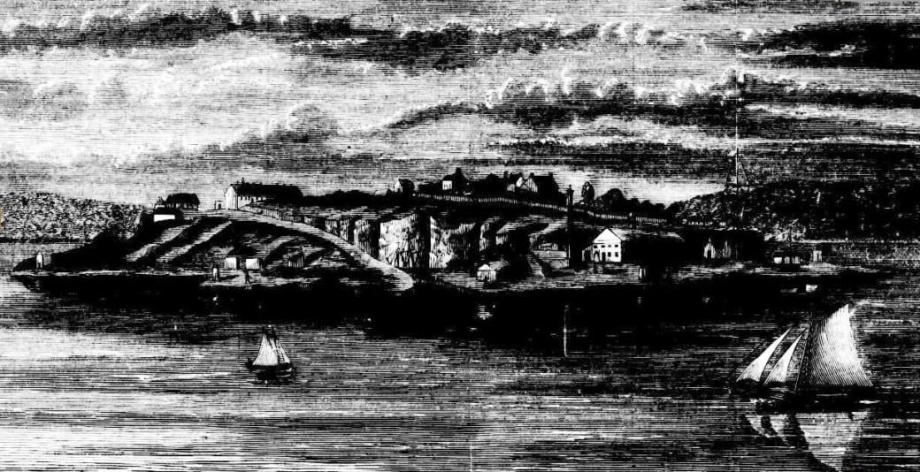
THIS islet of sandstone rock, lying in the Parramatta River, about three miles from Sydney, has a name which will live in the criminal history of the colony long after all traces of its penal character have disappeared. Already the fiat has gone forth that its criminal population is to be removed, and give place to other inhabitants than the worst of our felonry. Dating back to an early period in the annals of Australian settlement," Cockatoo " has attained an unenviable notoriety, having, from time to time, been the residence of some of the most noted criminals of England and New South Wales, and, in this respect, was second only to Norfolk Island. The prisoners' quarters are situated on the north-western end of the island. The superintendent's quarters occupy a prominent site on the eastern side and on the southern shore is the Fitzroy dry dock.
The latter is the finest of the kind south of the Line. It is hewn out of the solid rock, and perfect in its details. Many of the largest war vessels that have visited our port have been repaired there, and the Duke of Edinburgh's frigate, Galatea, underwent a complete overhaul. Captain Mann, who is at present superintendent of the island, will not be affected by the proposed change, but will continue to have charge of the dock, &c. COCKATOO ISLAND. (1869, August 5). Illustrated Sydney News (NSW : 1853 - 1872), p. 9. Retrieved fromhttp://nla.gov.au/nla.news-article63514595
The prisoners in confinement at Cockatoo Island were transferred from that place to Darlinghurst Gaol on Thursday last, Cockatoo Island being relinquished as a penal establishment. THE SYDNEY MONTHLY OVERLAND MAIL. PER MAIL STEAMER GEELONG. (1869, November 5 - Friday). The Sydney Morning Herald (NSW : 1842 - 1954), p. 5. Retrieved fromhttp://nla.gov.au/nla.news-article13194605
It is reported that the Government intends to convert the Vernon, now being used as a training ship, into a lightship, and to place the boys on Cockatoo Island, a small vessel being kept near the island for their nautical training. NEW SOUTH WALES. (1869, August 14). The Ballarat Star (Vic. : 1865 - 1924), p. 2. Retrieved from http://nla.gov.au/nla.news-article112891548
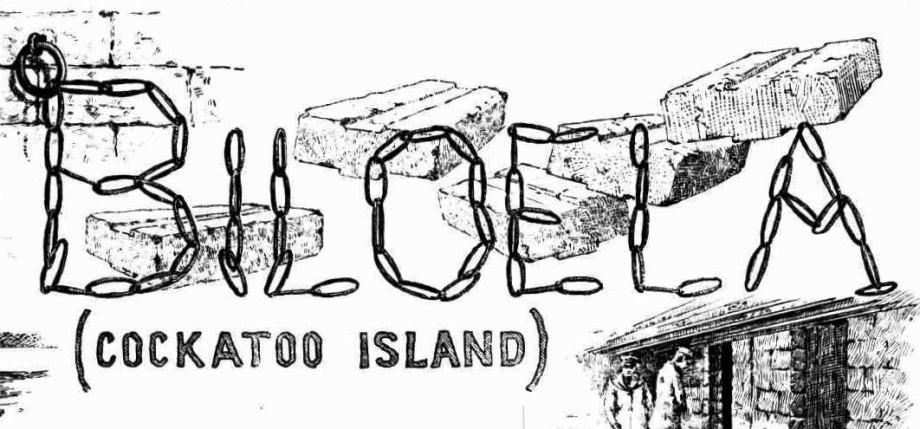
THE chief historic spot on the Parramatta River is, without doubt, Cockatoo Island; and this partly because it has been associated in the past with some of the darkest and most romantic pages of the colony's history, and partly because of the engineering works which have been constructed there. The early aboriginal title applied to Cockatoo Island was Warrieubah, and whether the early settlers, finding this to be the native name of the bird, translated it into English or whether they called the place so because of the numbers of this particular bird to be found in the neighbourhood, certain it is that from a far-back period this spot has borne the name of Cockatoo Island. It is the largest of all the islets that dot the waters of Port Jackson. Like the whole of them it is a mass of sandstone uprising from the harbour depths, its peculiarities being that it is of more imposing extent, of loftier elevation, and of more barren aspect than the others. In outline it is rugged and severe, consisting of an elevated plateau, ending everywhere with sheer abrupt sides, which, in their turn, meet a lower level not much above the water's surface, and which, to a great extent, has been formed by the rubble quarried from other portions of the island. Cockatoo lies pretty well in midstream, between Balmain and the peninsula running from Hunter's Hill, known as ‘Onion's Point,' and is surrounded by deep water.
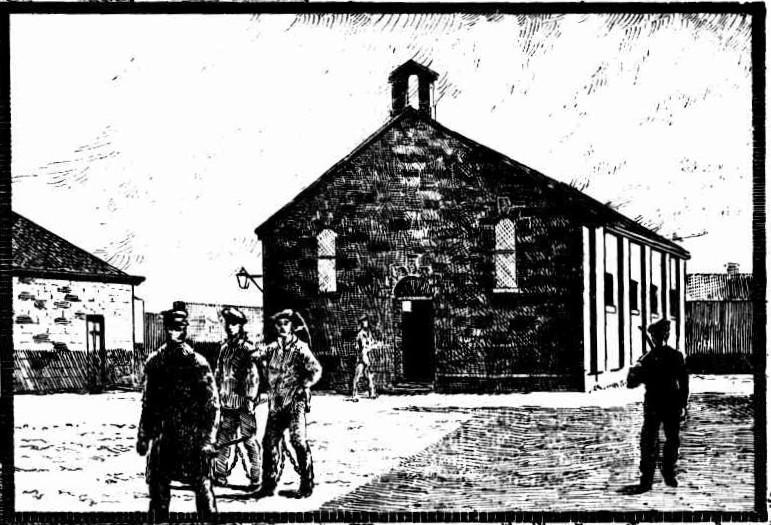 The ground plan of the island in configuration is a square, or rather an oblong, being about a quarter of a mile wide, and somewhat more than that in length. In its longer dimensions it lies up and down stream from east to west. For the first fifty years of Australian settlement, Cockatoo Island was left in all its native wild and solitary state. Only when 'The Lump’ passed-that earliest and heaviest specimen of Australian boat-building-with the convicts toiling like veritable galley slaves at the oar ; or when some of the fruit boats of the pioneer settlers at Ryde or Kissing Point came down the river with a cargo of oranges and peaches, was the solitude of the scene at all broken. Black- fellows would fish from their bark canoes round the rocky fringe of the island, or build their fires on its shores. At that time the regular penal settlements at Norfolk Island, Van Diemen's Land, and Port Macquarie, together with old local gaols at Sydney and Parramatta, furnished sufficient accommodation for the criminal population not otherwise scattered over the colony engaged in road-making and other public works. The prison hulks also served to house some of the surplus crime, and, in the ' thirties,' Groat Island, adjacent to Cockatoo, had been converted into a sort of harbour gaol.
The ground plan of the island in configuration is a square, or rather an oblong, being about a quarter of a mile wide, and somewhat more than that in length. In its longer dimensions it lies up and down stream from east to west. For the first fifty years of Australian settlement, Cockatoo Island was left in all its native wild and solitary state. Only when 'The Lump’ passed-that earliest and heaviest specimen of Australian boat-building-with the convicts toiling like veritable galley slaves at the oar ; or when some of the fruit boats of the pioneer settlers at Ryde or Kissing Point came down the river with a cargo of oranges and peaches, was the solitude of the scene at all broken. Black- fellows would fish from their bark canoes round the rocky fringe of the island, or build their fires on its shores. At that time the regular penal settlements at Norfolk Island, Van Diemen's Land, and Port Macquarie, together with old local gaols at Sydney and Parramatta, furnished sufficient accommodation for the criminal population not otherwise scattered over the colony engaged in road-making and other public works. The prison hulks also served to house some of the surplus crime, and, in the ' thirties,' Groat Island, adjacent to Cockatoo, had been converted into a sort of harbour gaol.
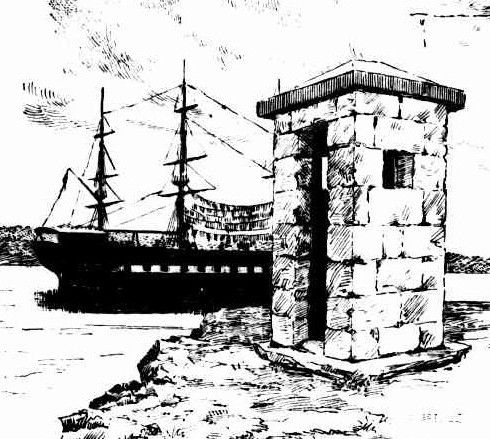 Cockatoo Island was first established as a depot for prisoners in February, 1839-just fifty years ago-and by proclamation was constituted the penal establishment of New South Wales on June 7, 1841. The convicts, who were first deported thither were occupied for a considerable period in quarrying stone for the necessary buildings, and also in constructing with the ballast an extensive wharf, or plateau, at the eastern extremity of the island.
Cockatoo Island was first established as a depot for prisoners in February, 1839-just fifty years ago-and by proclamation was constituted the penal establishment of New South Wales on June 7, 1841. The convicts, who were first deported thither were occupied for a considerable period in quarrying stone for the necessary buildings, and also in constructing with the ballast an extensive wharf, or plateau, at the eastern extremity of the island.
Wherever the configuration of the rugged isle permitted, a similar level was projected, so that a sentry-box could be placed at intervals, and a cordon of sentinels thus command the entire circumference. Later on they were 'engaged in excavating a capacious dry-dock from the solid rock, of which work more will be said further on.
As time went on, and the original transported convict element, under the jurisdiction of the New South Wales authorities, became concentrated at Cockatoo, and in 1850 there were only between three and four hundred thus lingering out the remaining penalty of their crimes.
A writer of that period, who visited the island says : 'Very many transported persons have thoroughly reformed. Very many were not radically vicious, but owed their fall to bad example, and bad counsel. The wheel of fortune may have played them an ugly turn or two in the youth of some; but they have seen their errors, felt the consequences of them, and learnt, moreover, the value of character and conduct. But the blemish is irradicable ; like a broken-knee'd horse, they may continue to work-and work as well as their more spotless fellow-men-but they never meet again with that implicit trust which those who have never "been down " have a right to expect. So little is what may be styled active convictism now apparent in Sydney, that a stranger might be unaware that any remains of the system still exist.
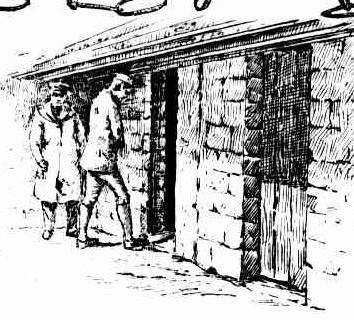 The prisoners under custody and punishment are all confined to Cockatoo Island. This natural hulk is situated about two miles above Sydney, just where Port Jackson narrows into the creek called the Parramatta River, and about a quarter of a mile from either shore. Here is all that remains of that stupendous machinery which, from first to last, has introduced into and diffused through these colonies not less than 60,000 of Great Britain's offenders, and by whose agency, it may be said, this great fifth portion of the globe has been redeemed from the savage, and appropriated to the European family. The island contains at present about 300 prisoners-under conviction for offences committed in the colony, or expirees from Norfolk Island. Many of these are regular incurables, doubly and trebly convicted.'
The prisoners under custody and punishment are all confined to Cockatoo Island. This natural hulk is situated about two miles above Sydney, just where Port Jackson narrows into the creek called the Parramatta River, and about a quarter of a mile from either shore. Here is all that remains of that stupendous machinery which, from first to last, has introduced into and diffused through these colonies not less than 60,000 of Great Britain's offenders, and by whose agency, it may be said, this great fifth portion of the globe has been redeemed from the savage, and appropriated to the European family. The island contains at present about 300 prisoners-under conviction for offences committed in the colony, or expirees from Norfolk Island. Many of these are regular incurables, doubly and trebly convicted.'
In a letter dated June, 1850, the following information is furnished : Mr. V. Dumas, clerk in the Convict Department, Sydney, states that of these 60,000 transported prisoners, 38,000 are now filling respectable positions in life, and earning their livelihood in the most creditable manner. Of the residue, death and departures from the colony will account for the greater part; and I am enabled to state that only 370 out of the whole are now undergoing punishment of any kind.'
Having been used by the Imperial Government as a prison for many previous years-by an order dated the 2nd of April 1856, it was directed that after that date Cockatoo Island should be the destination of all prisoners sentenced to work on the roads and other public works of the colony.
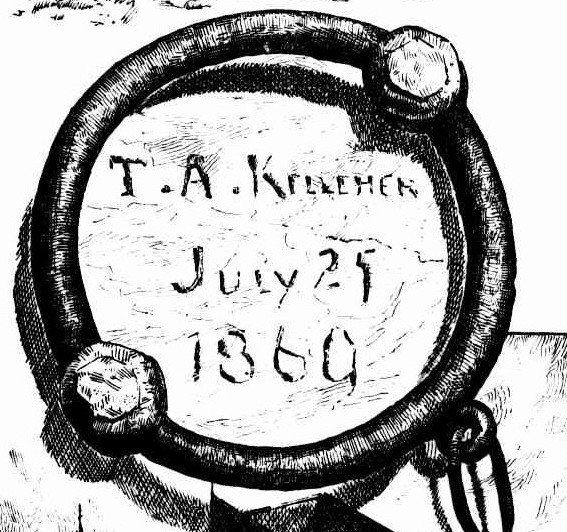 From that time it became associated with the names of several of the most daring bushrangers, who, for 'robbery under arms' and other desperate deeds, were relegated to this island prison-some with cumulative sentences whose long term left them but very little hope of lingering them out. One of the most notorious of these was Frank Gardiner, alias Christie, who was arrested at Apis Creek, Queensland, in 1864 for his share in the great gold-escort robber at Eugowra two years before, when several thousand ounces of gold were carried off by this bushranging gang, and two troopers Middleton and Hosie - were severely wounded. Tried and convicted before Sir Alfred Stephen, Gardiner's cumulative sentences amounted to 32 years hard labour but in consequence of his exemplary behaviour in gaol, and influence brought to bear on the Government of the day, he was released on the condition of leaving the colony for ever, which condition he fulfilled by sailing to San Francisco, where he opened a drinking saloon of the lowest type. Another notorious confinée at Cockatoo was Frederick Ward, who was much better known by his alias of 'Captain Thunderbolt’. He was one of the very few who ever escaped from this island-prison by swimming to the mainland. For the time being Nemesis suffered him to escape both the vigilance of sentries and the teeth of roaming sharks, but his taste of penal servitude did not deter him from resuming his evil career, and after escaping the hand of justice for seven years, during which he committed many deeds of violence, he was run to earth by a young trooper named Walker, and, refusing to surrender, was shot down.
From that time it became associated with the names of several of the most daring bushrangers, who, for 'robbery under arms' and other desperate deeds, were relegated to this island prison-some with cumulative sentences whose long term left them but very little hope of lingering them out. One of the most notorious of these was Frank Gardiner, alias Christie, who was arrested at Apis Creek, Queensland, in 1864 for his share in the great gold-escort robber at Eugowra two years before, when several thousand ounces of gold were carried off by this bushranging gang, and two troopers Middleton and Hosie - were severely wounded. Tried and convicted before Sir Alfred Stephen, Gardiner's cumulative sentences amounted to 32 years hard labour but in consequence of his exemplary behaviour in gaol, and influence brought to bear on the Government of the day, he was released on the condition of leaving the colony for ever, which condition he fulfilled by sailing to San Francisco, where he opened a drinking saloon of the lowest type. Another notorious confinée at Cockatoo was Frederick Ward, who was much better known by his alias of 'Captain Thunderbolt’. He was one of the very few who ever escaped from this island-prison by swimming to the mainland. For the time being Nemesis suffered him to escape both the vigilance of sentries and the teeth of roaming sharks, but his taste of penal servitude did not deter him from resuming his evil career, and after escaping the hand of justice for seven years, during which he committed many deeds of violence, he was run to earth by a young trooper named Walker, and, refusing to surrender, was shot down.
Having given some general outline of the isle as a penal settlement, we may now make some special reference to the illustrations which are contained in the present number of the NEWS. We have spoken of the stone-cutting performed by the convict masons. The one material on which the prisoners had to labour was rock, and that there was an inexhaustible supply.
All the quarrying, excavating, and stone-cutting on the island-with the exception of the magnificent new Dry Dock-has been the work of prison hands. The various buildings-such as gaols for their own confinement, cells for punishment, barracks for their guards, and residences for the officials-have all been constructed by convict labour, from stone hewn out of the island's own solid substance. Some of this masonry was of exceptionally strong and lasting character. A great number of the larger stones were cut in dove-tail fashion, so as to be fitted and held together without the aid of cement or mortar. A great many of the dove-tailed blocks are lying loosely about the island now, and of these we give a sketch at the head of our illustrated page, to show their character.
In the top left-hand corner stands a picture of one of the old stone sentry-boxes, which were placed at jutting points at intervals all round the island, so that the sentinels might see and signal to each other. This is the only one of the sentry-boxes now remaining, and is, on that account, quite an interesting relic. Note the look-out holes from which espionage could be maintained in every direction.
But, in spite of all this vigilance, escapes were frequently attempted, and in more than one instance proved successful.
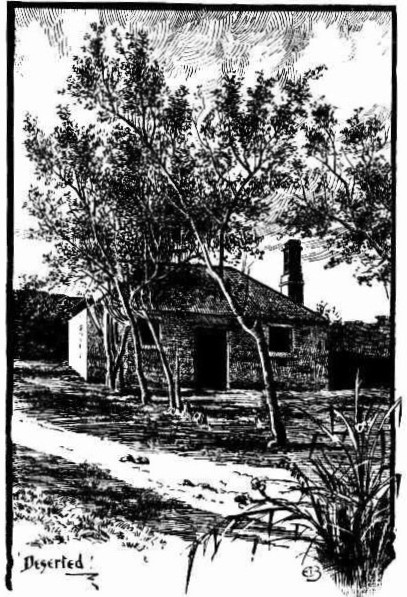 We have already quoted 'Thunderbolt's' case-others were not so fortunate. Mundy writes : 'Many desperate attempts at escape were made in my time. One wretched man flung himself into the water, loaded with chains, and, being a powerful swimmer, had got nearly a hundred yards from the pier before the sentry perceived him. Disregarding the soldier's shouts and threats, the man swam steadily onwards, upon which the sentry fired, and the wretch instantly sank, nor was his body ever found. Sharks in search of offal from the slaughter-houses haunt this part of the harbour, and act as an efficient cordon.'
We have already quoted 'Thunderbolt's' case-others were not so fortunate. Mundy writes : 'Many desperate attempts at escape were made in my time. One wretched man flung himself into the water, loaded with chains, and, being a powerful swimmer, had got nearly a hundred yards from the pier before the sentry perceived him. Disregarding the soldier's shouts and threats, the man swam steadily onwards, upon which the sentry fired, and the wretch instantly sank, nor was his body ever found. Sharks in search of offal from the slaughter-houses haunt this part of the harbour, and act as an efficient cordon.'
Right: THE TASKMASTER'S HOUSE, COCKATOO ISLAND.
The sketch below that of the sentry-box delineates one of those numerous inscriptions which are always to be found in places of this character. It was inscribed by the son of one of the warders as a memento of the date when the island was abandoned as a place of convict punishment and converted to other uses.
One of the most interesting relics of olden times to be found at Cockatoo was the set of siloes for storing grain, which were excavated in the days of Governor Bligh.
The storage of grain in siloes is evidently a very ancient custom. Several instances have occurred in Spain of the accidental discovery of subterranean stores of grain in good preservation, of which there existed no recollection, but which had probably been established by the Moors while they were lords of the soil. An elevated site is fixed upon for such constructions, if possible the pinnacle of a small mount, so that there can be no drainage of water into the granary from higher ground in its vicinity. A pit is sunk, resembling an inverted lime-kiln ; the depth and other dimensions of course depending on the quantity it is required to contain.
A considerable time ago siloes were constructed on the Macarthur Estate at Camden, and those containing maize and millet, on being opened many months afterwards were found to have preserved their contents perfectly. Those excavated in the solid sandstone rock at Cockatoo Island were situated on the side facing towards Balmain, and were shaped like a huge bottle, fifteen or twenty feet deep by about the same in diameter, with a narrow neck, closed with a flat stone luted with plaster. About a dozen of these siloes, filled in time of plenty with grain, were intended as a reserve of food for seasons of famine, which (before Bligh's time) had more than once befallen the colony. It was a monopoly for the public benefit; but it is said that the plan was discountenanced and disallowed by the home authorities, possibly because they imagined it might interfere with agricultural interests. The siloes at Cockatoo were constructed of sufficient capacity to contain six thousand bushels of wheat. In our illustration the opening of one of them is seen, into which a convict labourer is emptying a sack of wheat; while in the background another is seen coming up the rising ground from the grain barge.
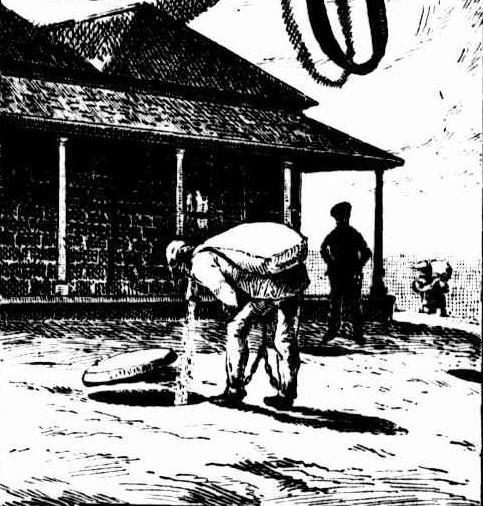 Mr. Doran--a very old resident on the island, connected with the dock engineering works, and a most intelligent man-informs us that when he first came to Cockatoo the siloes were full of grain, and that some time afterwards he assisted in emptying them, when the contents were found to be saturated with water. The grain was perfectly rotten, and the stench beyond endurance by those who were anywhere near. These siloes are still in existence. When emptied they were thoroughly purified and lime washed, and are now used as tanks, filled with beautiful water, supplying the island residents.
Mr. Doran--a very old resident on the island, connected with the dock engineering works, and a most intelligent man-informs us that when he first came to Cockatoo the siloes were full of grain, and that some time afterwards he assisted in emptying them, when the contents were found to be saturated with water. The grain was perfectly rotten, and the stench beyond endurance by those who were anywhere near. These siloes are still in existence. When emptied they were thoroughly purified and lime washed, and are now used as tanks, filled with beautiful water, supplying the island residents.
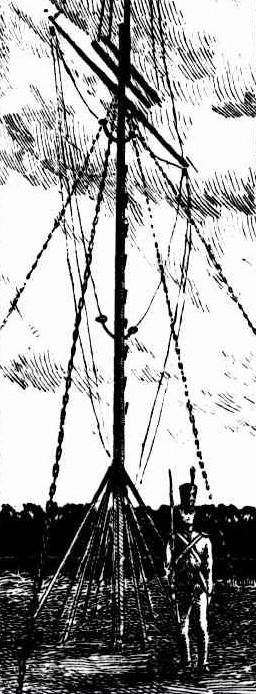 The Flag Station at Cockatoo formed a conspicuous object seen from a long distance, and still stands, a relic of the old times, when these signal staffs were erected on every salient point, to convey questions and answers before the days of the electric telegraph. The pole at Cockatoo is securely guyed by chains, and is stepped with cleats giving access to the cross-trees. At its foot our artist has sketched in one of the old time military sentries, with his plumed ‘ shacko,' and bayonet -fixed to old ' BrownBess.'
The Flag Station at Cockatoo formed a conspicuous object seen from a long distance, and still stands, a relic of the old times, when these signal staffs were erected on every salient point, to convey questions and answers before the days of the electric telegraph. The pole at Cockatoo is securely guyed by chains, and is stepped with cleats giving access to the cross-trees. At its foot our artist has sketched in one of the old time military sentries, with his plumed ‘ shacko,' and bayonet -fixed to old ' BrownBess.'
The picture set in lower centre of page gives us an idea of an early morning scene many years ago, when the prisoners, roused by sound of the bell, issued from the gaol dormitories, and the tools having been served out to them, they were told off to their daily task. An exorbitant amount of work was never expected of them; still there was an appointed task-master, or ‘ganger,' whose business it was to see that there was no 'shirking.' For those who were insubordinate, or refractory, there were the ' black holes' -the dark underground cells-where all was thick gloom, a darkness like that which fell upon the land of Egypt at the ninth plague-' a darkness which may befelt.' ; '
We give a separate illustration of the Taskmaster's House, which was ' deserted,' and is now all pulled down-even since our artist took his sketch-having been demolished in extending the surroundings of the new dock. Like Othello, ' his occupation gone,' he, himself, is in the condition of his occupation, and the tenantless, doorless, windowless house he once occupied has followed in the same direction. The task-master, in old convict days, was a man of some importance; he it was who supervised the day's work of each prisoner; he it was who, like Pharaoh's officers of old, cried' fulfil your works; your daily tasks !' and woe betide the unlucky wight who, from laziness or any other cause failed to fulfil his allotted day's labour. Those were the days of the dark cell, the triangle, and the 'cat,' and now it is only the silent evidence in the buildings around us, and the memories which, ghost-like, haunt the spot, that bring back the old "dark days " to mind.
Among other curiosities pointed out to the visitor to Cockatoo are the water-tanks, and the 'sentry's wash-basin.' In the first of these useful works we can trace the thoughtful provision of those who had the care and oversight of so large a body of people in such an isolated spot, in conserving the rain-catch. The water-tanks are so ingeniously constructed with adjoining filters; that any impurities conveyed into the first are separated from the water as it percolates into the second reservoirs. The largest of these tanks is about 50 feet square, and 8 feet deep, and they are at present filled with good water.
As to the 'Sentry's Wash Basin,' it is said to be the work of a prisoner in charge of the flagstaff, who was stationed there to look out for the coming of the visiting magistrate or doctor from the mainland, and give notice for all to be ready. The man cut the hollow in the rock for the purpose of washing ; and in those days the water ration was distributed by a prisoner 'water-carriers ' gang, who carried it in yoked buckets, and as they passed this sentry they gave him his supply into his 'basin.'
Altogether, Cockatoo is a sort of Crusoe's island to the Australian antiquarian, if anybody connected with a land so young can lay claim to such a title. He feels that here at least he has a spot on which is unrolled for him some of the dark annals of the past.
In 1872 Cockatoo Island was abandoned as a prison, and its name was changed to' Biloela,' which is said to particularise in the aboriginal tongue the female members of the cockatoo tribe. At all events the island was converted to feminine uses, for a sort of reformatory or industrial school for girls, who were living a destitute and dissolute life was established. The girls had to inhabit the old gloomy gaol buildings, with all their prison-like aspect and associations. There was nothing bright and cheerful about the place or its regime, to win those so disposed to a better life. And the chief defect or point of weakness in the whole system appeared to be its utter want of classification; the younger children were herded with the elder girls, who, although not so much their seniors in years, were considerably older in sin ; and thus, to a great extent, the opportunity was lost of improving those whose lives were as yet unblighted. Some of the more vicious girls were wild as unbroken colts, and led the others into oft-recurring acts of riot and insubordination, only equalled by the violence that used to be displayed in the Female Factory at Parramatta some half a century or more ago.
(To be continued). PARRAMATTA RIVER.—Past and Present. (1889, November 14). Illustrated Sydney News (NSW : 1881 - 1894), p. 16. Retrieved from http://nla.gov.au/nla.news-article63622225
Also see: Cockatoo Island Over the Years by George Repin

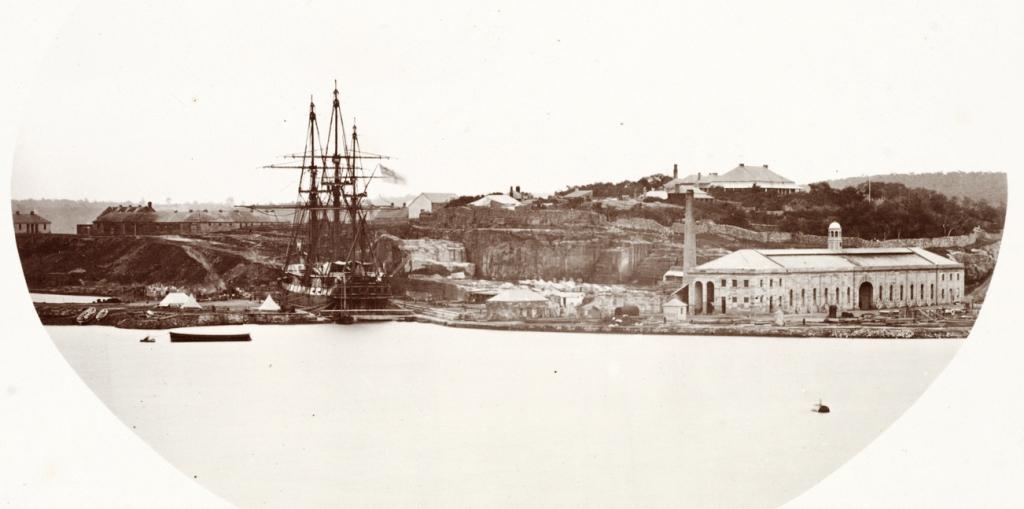
The Docking and Shoring of the Galatea
HMS Galatea, Ordered: 9 April 1856, Builder: Woolwich Dockyard, Engines by John Penn & Son
Laid down: 2 February 1857, Launched:14 September 1859 - Completed: By February 1862. Fate: Broken up in June 1883
General characteristics
Class and type: Ariadne class 26-gun sixth rate screw frigate
Displacement: 4,686 tons
Tons burthen: 3,227 bm
Length: 280 ft (85.3 m) (overall) , 245 ft 8 in (74.9 m) (keel)
Beam: 50 ft (15.2 m)
Depth of hold: 19 ft 4 in (5.89 m)
Propulsion: Sails , 2-cyl. horizontal single expansion, Rectangular boilers, Single screw 800 nhp 3,061 ihp = 11.796kts
Sail plan: Full rigged ship
Complement: 450
Armament: Middle deck: 24 x 10in (85cwt) MLSB shell guns (broadside), Upper deck: 2 x 68pdr (65cwt) MLSB (pivot-mounted), Later replaced by slide-mounted 110pdr Armstrong BLs
HMS Galatea (1859). (2014, May 8). In Wikipedia, The Free Encyclopedia. Retrieved from http://en.wikipedia.org/w/index.php?title=HMS_Galatea_(1859)&oldid=607590479
THE GALATEA.
In our issue of Saturday we merely mentioned that H M S Galatea had been safely docked. We are now in a position to give our readers a fuller description of this important operation.
On the morning of Monday, the 3rd instant, Commodore Lambert informed Captain Banks (representative of Mr. John Cuthbert) that it was decided the Galatea should be docked, and as she was drawing too much water, instructed him to make the necessary arrangements for lightening her, &o And here we may mention as an evidence of the immediate resources of Port Jackson, that, by 5 o'clock of the same day, a bulk of 1000 tons register was lashed alongside the Galatea ready to receive cargo. This hulk was the dismantled ship Golden South, owned by the Bulli Coal Company, and which has for months has loomed so large, as she lay at her moorings in Darling Harbour, but alongside the Galatea seemed so small as to forcibly impress the mind with the enormous size of this magnificent frigate.
On Tuesday the work of lightening commenced by transshipping the provisions, guns, shot, &c., and continued until Thursday afternoon at 4 o'clock, when the steam tugs and Commodore's orders to shift ship arrived simultaneously. Yet such is the celerity of the British Navy that by 5 o'clock she had left the Golden South in charge of her moorings, and was moving gracefully up the harbour by the muted power of the steam tugs Bredalbane, Vesta, and Herald lashed alongside, and every officer at his post, from her Royal Captain on the bridge to the midshipmen in charge of their respective boats following astern.
Our readers may not be aware that it is the practice of H M ships to be piloted even in harbour by their own officers, and such would also have been the case with the Galatea had they not been total strangers to Port Jackson, for which reason they availed themselves of the services of Captain Myles, Deputy Harbour Master, who piloted the vessel to the buoy off Fitzroy Dock, where she was safely moored by 6 p.m., having both sheet anchors clear in case of need, and in which position she was joined by Captain Mann, Governor of Cockatoo Island, under whose direction the vessel was then as usual placed; the practice being to heave the vessels in by warps. Captain Banks, however, to guard against accidents, arranged for the Bredalbane to be in attendance next morning, and for this purpose was alongside on Friday morning, at half-past 5, when the steamer was lashed alongside, by 6, the officers and crew being at their stations, and the Captain, the Duke of Edinburgh at his, on the bridge, with Captains Mann and Myles on board to assist by their suggestions, the ropes were got out to swing the vessel and haul her into dock About half-past 6 the order was given to slip, and the noble vessel swung round with her head towards the dock entrance, and the steamer giving a turn ahead the bows entered. Unfortunately at this time, a smart squall with rain struck the vessel’s broadside and might have caused serious consequences, had not the Bredalbane promptly got a rope from the starboard quarter, and by a powerful tug to windward enabled the starboard quarter hawser to be hove in smartly, by which the vessel squared and shunted into -dock, where Messrs. Brodwick and Johnson were ready to receive her, having under their instructions a gang of carpenters led by Mr. Kendal, the chief foreman of Mr Cuthbert’s establishment, who had quickly two tier of shores along the vessel's side, which were tightly wedged as the ship took the blocks about eight o'clock, her draught being 20 feet 8 inches aft and 21 feet 2 inches water on the dock sill About 11 o'clock she was visited by Commodore Lambert and Commander Brownrigg, of H M S. Challenger, who expressed themselves highly satisfied with the security of the vessel, merely suggesting the use of a few more shores.
Only a portion of the water was pumped out on Friday but on Saturday everything being ready, the dock was quickly dried, and the bilges shored up, giving a full view of the vessel's bottom, and displaying the extreme beauty of her lines.
We cannot close this report without congratulating the colony on its safe accomplishment, and Captain Mann on having safely landed on terra firma, the largest vessel which his yet been docked in a British colony. THE GALATEA. (1868, February 10). The Sydney Morning Herald (NSW : 1842 - 1954), p. 4. Retrieved from http://nla.gov.au/nla.news-article13157055
Above: Cockatoo Island; H.M.S. "Galatea" in Dock - Below: Dry Dock, Cockatoo Island - from Album: Photographs of Public and Other Buildings, &c ... / photographed by Charles Pickering - 1872, courtesy State Library of NSW. Available Online - See: acms.sl.nsw.gov.au/item/itemDetailPaged.aspx?itemID=442753
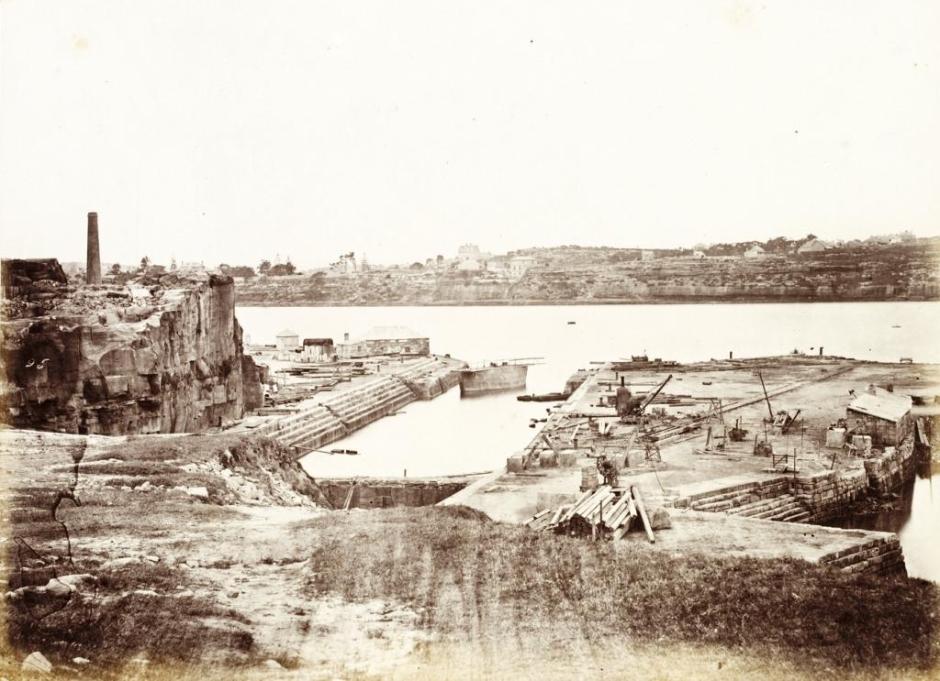
THE NEW FITZROY GRAVING DOCK, COCKATOO ISLAND, PORT JACKSON.
The Fitzroy Graving Dock.
THE rapid extension of the shipping trade of Sydney, now the chief port of Australia, and the terminus of most of the large ocean going steam ships, is one of the surprising circumstances in connection with the progress of New South Wales, and of Australia generally. Some of the largest and finest steam and sailing ships afloat regularly visit Sydney. In view of this fact it has been recognized by the shipping community, and by the public works authorities, that increased facilities for the docking and repair of those magnificent vessels is absolutely necessary. Sydney is not, at even this time, quite behind the age in this particular. For some years a graving dock has been in existence at Cockatoo,which will accommodate large vessels. Then there is the dry dock at Mort and Co.'s works, Mort's Bay, Balmain ; in addition to these there are patent slips capable of taking up vessels of 1000 tons ; also floating docks. But as the size of the steamers visiting the port increased it was felt that it was necessary to be prepared for all contingencies. Accordingly, sjme three or four years ago, it was determined to construct a very large graving dock, at Cockatoo Island, in close proximity to the existing one. A sum of £150,000 was voted by Parliament, and the work commenced. Operations have been continuous ever since.
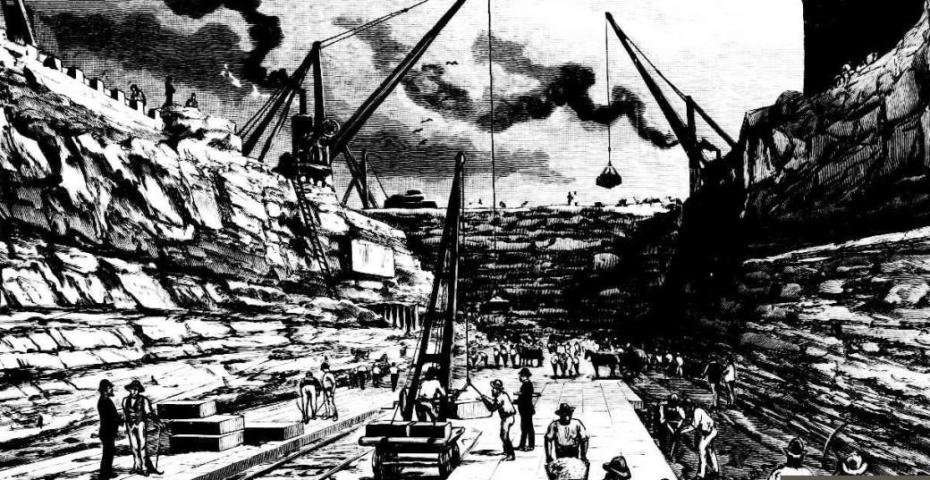
The excavations are out of the solid sandstone rock, so that of the stability and durability of the work there can be little question. The length will be 630 feet, and the width 108. The depth of water on the sill will be 28 feet at neap, and30^ feet at spring tide. The width of entrance will be84 feet, it is said that it will be the largest single graving dock in the world, and capable of accommodating the largest vessels now afloat. All the recent improvements which modern science has discovered and approved will be applied in the arrangement of the dock. Powerful pumps, capable of emptying the dock of water in about an hour will be erected, and the electric light will be utilized in carrying on operations' by night. This great national undertaking has been designed by Mr. Moriarty, Engineer-in-Chief of Harbours and Rivers, and the work is being carried on under his directions and the supervision of the officers of his department. Considerable progress has been made with the excavations, and it is probable that the dock will be ready for the reception of ships in the course of another twelve or eighteen months. Our illustration, which gives an idea of the magnitude of the work, is engraved from sketches taken by a special artist on the spot within the past few days. The construction of the dock has rendered necessary a number of operations outside, in order to effect a proper and safe approach to the entrance. Our artist also gives a sketch of these, which we engrave, showing divers at work. The progress of such an undertaking as the new Fitzroy Graving Dock is necessarily slow. But there is this to be said of it, that the labour of the constructors is enduring, and will last for all time. The situation is the best that could be selected. It affords deep water all around, and is, it may be said, in the centre of the harbour, close to the wharves, docks, and large engineering establishments. When finished it will have the effect of making Sydney the most completely provided shipping port south of the equator. The Fitzroy Graving Dock. (1886, February 15).Illustrated Sydney News (NSW : 1881 - 1894), p. 8. Retrieved from http://nla.gov.au/nla.news-article63619988
In Text: a840123 - ship in dry dock at Cockatoo Island from: Album of views, illustrations and Macarthur family photographs, 1857-66, 1879 / by various photographers - Creator Sir William Macarthur, 1800-1882
Cockatoo Island - Convict Insights and Dry Docking of Galatea threads gathered and collated by A J Guesdon, 2015.